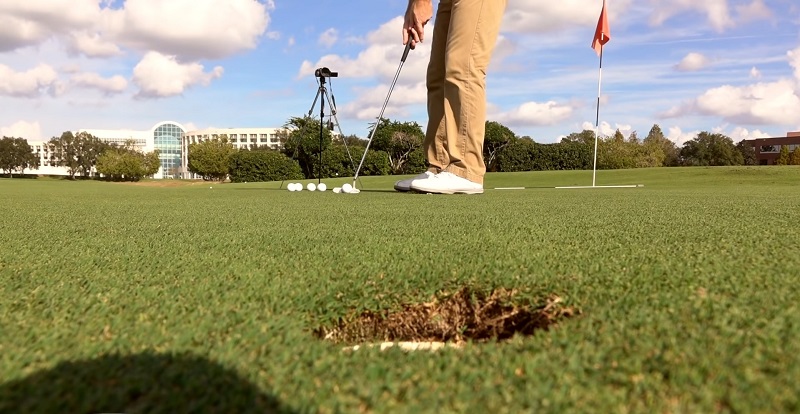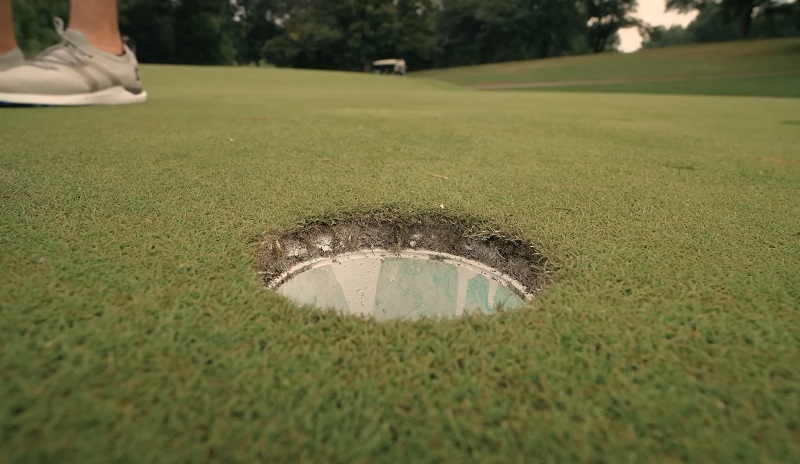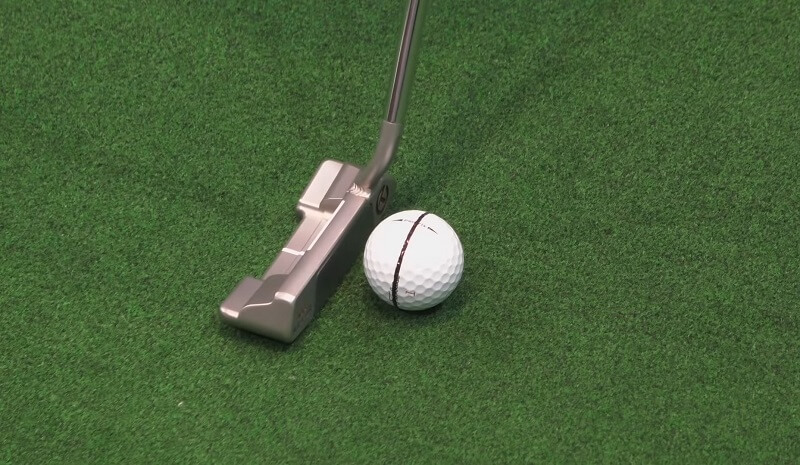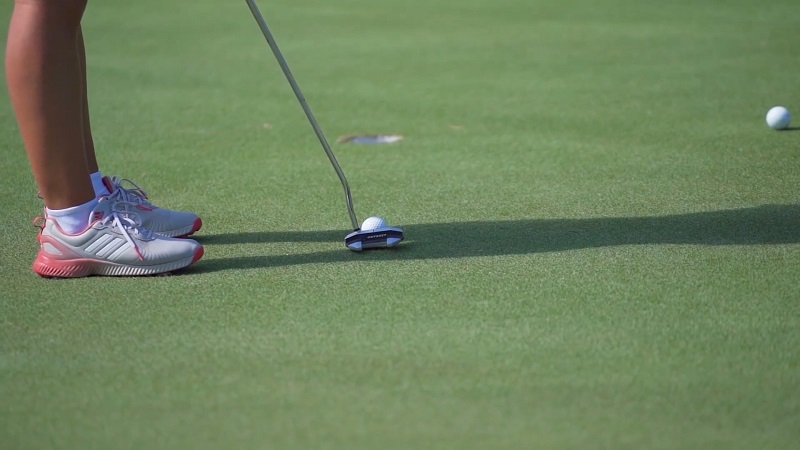If you’re a beginner golfer, the world of golf can seem intimidating. You see the pros on TV smoothly sinking putts and wonder how they do it so easily? Well, worry not!
Regardless of your level of expertise in golf, learning to putt correctly is relatively straightforward when you break it down into simpler steps. With this guide as your roadmap, you should be fine with perfecting your technique and mastering the skill quickly!
What Is Golf Putting?

Golf putting is a technique used to roll the ball into the hole on the putting green with a putter. It is one of the most crucial aspects of the game and often determines a player’s score. Putting requires precision, control, and accuracy, as well as understanding factors like green speed, slope, and break. Good putting can save strokes on the golf course and make a significant difference in a golfer’s overall game.
Why Is A Golf Putting Important?
Golf putting is essential because it accounts for a significant portion of a golfer’s score. On a standard 18-hole course, roughly 60% of the strokes are putts. Good putting can help golfers save strokes, while poor putting can be detrimental to a player’s game.
Additionally, putting is a unique aspect of the game that requires a different set of skills than driving or iron shots. It requires precision, control, and a good understanding of green speed, slope, and break factors. Becoming proficient in putting can help golfers improve their overall game and lower their scores.
Lastly, golf putting is also a mental game, as it requires focus, concentration, and the ability to manage pressure. A player’s mindset can significantly impact their putting performance, and learning how to manage stress and stay calm under pressure can be invaluable to their overall success on the golf course.
How To Putt a Golf Ball?

Putting a golf ball requires a combination of proper technique, focus, and practice. Here are the basic steps to putt a golf ball:
Position yourself
Stand behind the ball and pick out a target line, which is the line the ball needs to travel to reach the hole. Visualize the path the ball will take as it rolls toward the hole. Then, align the ball with the center of the target line.
Position your feet
Place your feet shoulder-width apart and parallel to the target line. Your weight should be evenly distributed between your feet.
Grip the putter
Use a grip that feels comfortable and secure to you. There are various grips that golfers use, such as the traditional, cross-handed, or claw grip. Experiment to find what works best for you.
Position your eyes
Align your eyes over the ball and down the target line. Your eyes should be directly above or slightly inside the ball, allowing you to see the line clearly. Ensure your shoulders and arms are relaxed, and your head is still.
Take your stance
Position the putter head behind the ball and square the clubface to the target line. Lean slightly forward from the waist, with your weight evenly distributed on the balls of your feet. Keep your arms relaxed and your elbows close to your body.
Start the stroke
Use your shoulders to start the stroke, taking the putter back with a smooth and controlled motion. Keep the putter face square to the target line throughout the backswing. Avoid any jerky or sudden movements.
Accelerate through the ball
As you swing the putter forward, accelerate through the ball with a smooth and consistent stroke, striking the ball in the center of the putter face. Keep your wrists firm and your arms relaxed. The speed and distance of your putt will depend on the length of your backswing and the pace of your forward swing.
Follow-through
Allow the putter to follow through naturally, keeping your head still and your body in position until the ball has reached its destination. Avoid any abrupt or sudden stops.
Watch the ball
Keep your eyes on the ball as it rolls towards the hole, focusing on speed and direction. Keep your head still, and your body relaxed. Once the ball has reached its destination, take note of your position and adjust your technique if necessary.
Remember that putting is a skill that takes time and practice to master. Experiment with different techniques and find what works best for you. Focus on maintaining a smooth and consistent stroke, and stay relaxed and focused throughout your putt.
What Are The Putt Drills To Improve Your Skill?

Once you have mastered the basics of golf putting, it is important to practice golf drills to improve your golf putting game. Golf drills help golfers refine their skills and develop a consistent golf swing. Here are some golf drills that can help you improve your golf putting:
Gate Drill
The gate drill is a popular drill for improving putting accuracy. To set up the drill, place two tees or alignment sticks in the ground just wider than the width of your putter head, creating a “gate” to putt through. Stand a few feet away from the gate and practice hitting putts through the gate, focusing on keeping your putter head square and on line. You can gradually increase the distance to the gate as you improve.
One-Handed Putting Drill
The one-handed putting drill is a great way to improve feel and touch in your putting stroke. To practice, grip your putter with just your left hand (for right-handed golfers) or right hand (for left-handed golfers) and hit putts with a smooth, controlled motion. This drill can help you develop a more consistent and effective putting stroke.
Distance Control Drill
Distance control is a key skill for effective putting. To practice, place a series of balls at different distances from the hole, and practice hitting putts to each ball in succession. Focus on maintaining a consistent putting stroke and making solid contact with the ball. This drill can help you develop better distance control and accuracy on the greens.
Putting Arc Drill
The putting arc drill is great for improving your putting stroke mechanics. Use a putting arc or create your own with two alignment sticks to practice your putting stroke. Place the arc on the ground and practice swinging your putter along the arc, ensuring that your putter head stays square to the target line. This drill can help you develop a more consistent and effective putting stroke.
Line Putting Drill
The line putting drill is a simple but effective way to improve putting accuracy. Place a straight line on the ground using an alignment stick or string. Practice hitting putts along the line, focusing on keeping your putter head square to the line and maintaining proper form. This drill can help you improve your putting accuracy and consistency.
Cross-Handed Putting Drill
The cross-handed putting drill involves using a cross-handed grip on your putter, with your left hand (for right-handed golfers) or right hand (for left-handed golfers) placed above your right hand on the grip. This grip can help you maintain a square putter face and improve your stroke mechanics. Practice hitting putts with a smooth, controlled motion, focusing on keeping your putter head on the line and making solid contact with the ball.
What Are Common Mistakes In Golf Putting?
Putting is a crucial part of golf, but many golfers make common mistakes that can affect their putting performance. To help you improve your game, let’s take a closer look at these common mistakes and how you can fix them.
- One common mistake is improper alignment. This means you’re not lined up correctly with the target. To fix this, start by standing behind the ball and taking some practice swings while looking at the target. Then, make sure your feet, hips, and shoulders are aligned with the target line.
- Another mistake is poor distance control. You can fix this by focusing on your stroke tempo and grip pressure. A smooth, even tempo can help control the distance of your putt, and a light grip pressure can help you maintain a consistent stroke.
- Many golfers also grip the putter too tightly, causing tension in the wrists and forearms. To fix this, try gripping the putter lightly and relax your muscles.
- It’s also important to keep your head still during the stroke to avoid any unnecessary movement affecting your accuracy.
- Don’t rush your putting stroke! Take your time, and focus on your setup and alignment before making your stroke.
- Make sure you take enough time to read the green and observe the slope and contour of the green to help you make a more accurate putt.
- Finally, misreading the break is another common mistake. Take the time to observe the slope and contour of the green and adjust your aim accordingly. Practice putting on different greens with varying slopes to improve your ability to read the break.
By focusing on these common mistakes and using these tips to fix them, you can improve your putting performance and reduce your scores on the green. Keep practicing and seek advice from a golf professional if you need further guidance.
Final Thoughts
Putting a golf ball is an essential part of the game and can make or break a round. By following this guide, you can give yourself the best chance of success on the putting green. Focus on balance and aim, control your emotions and take slow, deliberate strokes with your putter. Don’t be too quick to change up your technique just because it’s not working for you in the moment.
All of this practice will help you build confidence in your ability to read a green and hit good putts when it matters most. Put in some extra practice time on the putting green, and soon enough you’ll be able to hole out with ease and feel confident about every touch around the cup. Good luck out there!
Golf Putting FAQs
What Golf Equipment Do I Need For Golf Putting?
The most important piece of equipment you will need is a putter. Other useful items include golf balls, alignment sticks, towels and gloves, and golf apps or simulators to help with your aim.
How Often Should I Practice Golf Putting?
It is recommended to practice golf putting at least twice a week, but more often if possible. Aim for an hour each session and try to focus on a particular aspect of your game, such as alignment or distance control.
What Is The Best Golf Putting Tips For Beginners?
The best tips for golf putting beginners are to focus on proper alignment, setup and posture, as well as developing a smooth and consistent stroke. Additionally, practice reading the break of the green so you can adjust your aim accordingly. Finally, take your time when putting and be sure to observe the slope of the green before making your stroke.
What Should I Do If I Miss A Golf Putt?
If you miss a golf putt, take a step back and assess the situation. Identify where your mistake was and consider what could have been done differently to make the shot successful. Taking some time to reflect on the situation can help you improve for future putts. Lastly, remember to stay positive and focus on the next shot!
What Golf Etiquette Should I Follow?
Golf etiquette is important for all golfers to follow. This includes being respectful of other players and following the rules of the course. Additionally, be sure to repair any divots or ball marks on the green before leaving, as well as rake bunkers after use. Finally, maintain a consistent pace of play so everyone can enjoy their time on the course.


